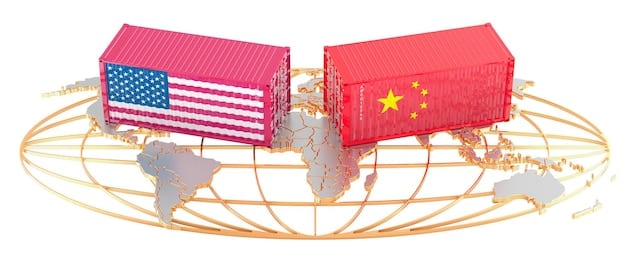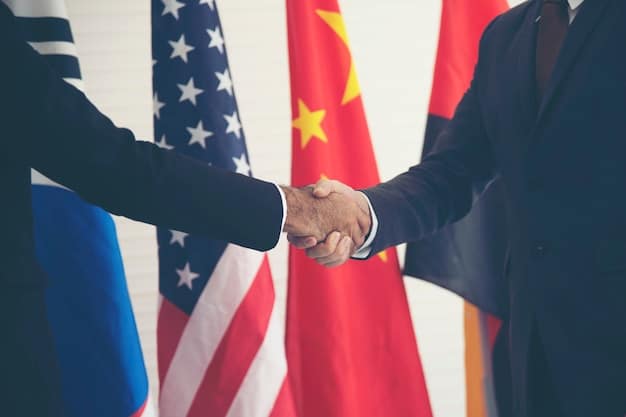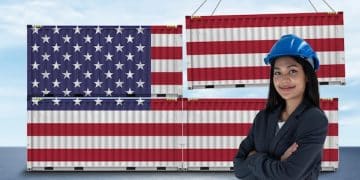Alert: New China Tariffs & Impact on US Businesses

New tariffs on imported goods from China are poised to significantly impact US businesses, potentially raising costs, disrupting supply chains, and affecting competitiveness in both domestic and international markets.
The US trade landscape is shifting once again. New tariffs on imported goods from China are on the horizon, and businesses across the United States need to understand the potential consequences. This article will delve into the details of these tariffs, exploring how they might affect your business operations and offering strategies to navigate these changes.
Understanding the New Tariffs on Chinese Goods
Before we can strategize, it’s crucial to understand the specifics. What goods are affected? What are the tariff rates? Understanding the scope of these new tariffs on imported goods from China is the first step in assessing their potential impact on your business.
What Goods Are Affected?
The range of products subject to the new tariffs can vary, from raw materials and components to finished consumer goods. Key sectors often impacted include electronics, textiles, machinery, and certain agricultural products. It’s crucial to consult the official tariff schedules published by the US government to determine if your specific imports from China are affected.
Current Tariff Rates
Tariff rates can range from a few percentage points to significantly higher levels, depending on the specific product and the trade policies in effect at the time. Some goods may be subject to rates as low as 7.5%, while others can face tariffs exceeding 25%. Regularly monitoring updates from the US Trade Representative (USTR) can help you stay informed about the specific rates applicable to your imports.

The impact goes beyond just direct costs.
- Increased costs of goods: Tariffs are essentially taxes paid by importers, which can translate to higher prices for consumers.
- Supply chain disruptions: Businesses that rely on Chinese suppliers may face challenges in finding alternative sources or absorbing the increased costs.
- Reduced competitiveness: US companies that compete with foreign businesses not subject to the same tariffs may find themselves at a disadvantage.
Staying informed is key to navigating the situation.
In conclusion, understanding the specifics of the new tariffs, including the affected goods and their rates, is crucial for businesses to assess the potential impact on their operations. Monitoring official sources and consulting with trade experts can provide valuable insights and inform strategic decision-making.
Assessing the Impact on Your Specific Business
The generalized effects are one thing, but how will these tariffs affect *your* business specifically? This requires a thorough analysis of your supply chain, customer base, and competitive landscape. A detailed assessment is essential to determine how to best respond to the changes resulting from the new tariffs on imported goods from China.
Several facets require consideration.
- Review your supply chain: Identify which of your suppliers are based in China and what percentage of your inputs are subject to tariffs.
- Analyze your pricing strategy: Determine whether you can absorb the increased costs or if you need to pass them on to consumers.
- Evaluate your competitive position: Assess how your competitors are responding to the tariffs and whether you can maintain or improve your market share.
Consider alternative sourcing. Can you find suppliers outside of China who can provide similar goods at competitive prices?
Diversifying Your Supply Chain
Diversification can reduce your reliance on any single supplier or country. Exploring options in Southeast Asia, South America, or even reshoring production to the US could mitigate the impact of the tariffs.
Ultimately, assessing the impact involves both internal analysis and external awareness.
In conclusion, assessing the impact of the tariffs on your specific business requires a comprehensive analysis of your supply chain, pricing strategy, and competitive position. By proactively evaluating these factors, you can develop informed strategies to mitigate the potential negative effects and adapt to the changing trade landscape.
Strategies for Mitigating the Tariff Impact
Okay, so you know the tariffs are coming and you’ve assessed their potential impact. What can you do about it? There are several strategies businesses can employ to mitigate the negative effects of the new tariffs on imported goods from China, from negotiating with suppliers to exploring tariff exclusions.
There are key options to consider.
Negotiating with Suppliers
Open communication with your suppliers in China is important. Can they absorb some of the cost increases? Are there opportunities to renegotiate contracts or explore alternative pricing arrangements?
Seeking Tariff Exclusions
The US government may offer tariff exclusions for certain products or industries. Research whether your specific imports qualify for an exclusion and, if so, apply for it.

Don’t forget these approaches either.
- Pass costs on to consumers: Carefully consider the market’s price elasticity.
- Improve internal efficiencies: Reducing waste and streamlining processes can offset some of the increased costs.
- Explore alternative markets: Diversifying your customer base can reduce your reliance on the US market.
Mitigation is not a one-size-fits-all solution.
In conclusion, businesses can employ various strategies to mitigate the impact of tariffs, including negotiating with suppliers, seeking tariff exclusions, passing costs on to consumers, improving internal efficiencies, and exploring alternative markets. A combination of these approaches, tailored to your specific business circumstances, can help minimize the negative effects and maintain competitiveness.
Legal and Regulatory Considerations
Navigating the complex world of international trade law can be daunting. Understanding the legal and regulatory aspects of these new tariffs on imported goods from China is crucial for ensuring compliance and avoiding potential penalties. Legal expertise is essential to ensure you’re following all regulations.
Proper understanding is key.
Compliance with Customs Regulations
Ensure that you are accurately classifying your imported goods and complying with all customs regulations. Errors in classification can result in fines and penalties.
Understanding Trade Agreements
Familiarize yourself with any existing trade agreements between the US and China, as well as any potential changes or updates to these agreements. These agreements can impact tariff rates and trade policies.
Furthermore, stay informed on policy.
- Consult with legal counsel: Seek advice from experienced trade lawyers who can guide you through the complexities of international trade law.
- Monitor regulatory updates: Stay abreast of any changes to tariff regulations or trade policies that may affect your business.
- Maintain accurate records: Keep detailed records of all import transactions, including invoices, shipping documents, and tariff payments.
Navigating these challenges requires a proactive and informed approach.
In conclusion, navigating the legal and regulatory landscape surrounding tariffs requires a thorough understanding of customs regulations, trade agreements, and legal expertise. By ensuring compliance, consulting with legal counsel, and staying informed about regulatory updates, businesses can minimize the risk of penalties and operate within the bounds of the law.
The Future of US-China Trade Relations
Predicting the future is never easy, but understanding the potential trajectories of US-China trade relations is essential for long-term planning. The current situation with new tariffs on imported goods from China might be a temporary measure, or it could signal a more profound shift in the trade landscape. Strategic planning is vital for those who trade with China.
What can we anticipate?
Potential Scenarios
Several scenarios are possible, ranging from a negotiated resolution that reduces or eliminates tariffs to a further escalation of trade tensions. Geopolitical factors, economic conditions, and political considerations will all play a role in shaping the future of US-China trade.
Long-Term Implications
Regardless of the specific outcome, businesses need to be prepared for long-term changes in the way they operate. This may involve diversifying supply chains, investing in new technologies, or adapting their business models to a more protectionist environment.
Consider how these things could play a role in the future.
- Monitor geopolitical developments: Stay informed about political and economic developments that could impact US-China trade relations.
- Develop contingency plans: Prepare alternative strategies for different potential scenarios, such as further tariff increases or a complete breakdown in trade relations.
- Invest in resilience: Build a business that is adaptable and resilient to changes in the external environment.
The future may be uncertain, but proactive preparation is key.
In conclusion, predicting the future of US-China trade relations is challenging, but businesses must remain vigilant and prepare for various potential scenarios. By monitoring geopolitical developments, developing contingency plans, and investing in resilience, businesses can navigate the uncertainties and adapt to the evolving trade landscape.
Seeking Expert Advice and Resources
You don’t have to go it alone. Many resources are available to help businesses navigate the complexities of international trade and mitigate the impact of the new tariffs on imported goods from China. Utilizing expert advice is a key strategy.
Trade Associations
Join industry-specific trade associations that can provide valuable information, advocacy, and networking opportunities. These associations often have experts who can offer guidance on tariff-related issues.
There are, as well, government resources to lean on.
- Consult with trade consultants: Hire experienced consultants who specialize in international trade and tariff mitigation strategies.
- Attend industry events: Participate in trade shows, conferences, and seminars to learn about the latest trends and best practices in international trade.
- Utilize government resources: Take advantage of resources offered by the US Department of Commerce, the Small Business Administration, and other government agencies.
Utilizing these avenues can make a difficult process go more smoothly.
In conclusion, businesses can benefit from seeking expert advice and utilizing available resources to navigate the complexities of international trade and mitigate the impact of tariffs. By joining trade associations, consulting with experts, attending industry events, and leveraging government resources, businesses can gain valuable insights and support to thrive in the global marketplace.
| Key Point | Brief Description |
|---|---|
| ⚠️ Assessing Impact | Evaluate how tariffs affect your supply chain and pricing. |
| 💡 Mitigation Strategies | Negotiate with suppliers, seek exclusions, improve efficiencies. |
| ⚖️ Legal Compliance | Comply with customs regulations; consult legal counsel. |
| 🔮 Future Planning | Monitor developments; develop contingency plans for trade relations. |
Frequently Asked Questions
Tariffs are taxes imposed on imported goods, typically paid by the importer. They increase the cost of imported products, potentially affecting prices for consumers and businesses. These taxes are a tool governments use for trade policy.
Consult the official tariff schedules published by the US government, specifically the US Trade Representative (USTR). These schedules will list the specific products subject to tariffs and the applicable rates. You can also consult with a trade lawyer.
Start by identifying your key suppliers in China and researching potential alternative sources in other countries. Southeast Asia and South America are often viable options. Consider reshoring some production to the US if feasible.
Yes, the Small Business Administration (SBA) and the US Department of Commerce offer resources for small businesses. Trade associations can also provide valuable information and support. Consult a trade consultant for personalized advice.
Tariff rates and regulations can change frequently depending on trade negotiations and policy adjustments. Stay informed by regularly monitoring updates from the USTR and consulting with legal counsel specializing in international trade.
Conclusion
The introduction of new tariffs on goods imported from China creates both challenges and opportunities for US businesses. By understanding the specifics of these tariffs, assessing their potential impact, and implementing proactive mitigation strategies, businesses can navigate the evolving trade landscape. Staying informed, seeking expert advice, and adapting to the changing environment will be essential for success.





